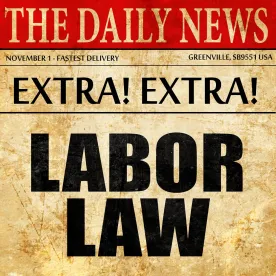October 10, 2022
-
The National Labor Relations Board has proposed reversing the current joint-employer standard, which took effect on April 27, 2020. The new rule would revert to the Obama-era standard for determining joint-employer status under the National Labor Relations Act. Under the proposed rule, entities may be deemed joint employers if they “share or codetermine those matters governing employees’ essential terms and conditions of employment.” These terms and conditions include wages, benefits and other compensation, work and scheduling, hiring and discharge, discipline, workplace health and safety, supervision, assignment, and work rules. While the Trump-era standard requires proving exercised control over the terms and conditions of work of another entity’s employees, the proposed rule states the authority to control such terms and conditions is sufficient to establish joint-employer status. The joint-employer analysis has significant implications for employers, as it determines when one entity can be held liable for the other’s unfair labor practices. The Board is accepting public comments on the proposed rule until November 7, 2022.
-
Major League Baseball (MLB) has voluntarily recognized the Major League Baseball Players Association (MLBPA) as the bargaining representative of minor league players. The MLBPA will collectively bargain the terms and conditions of employment for approximately 5,000 minor leaguers, after more than half of them signed union authorization cards indicating they wanted to join the players union. MLB released a statement acknowledging the union, stating it is hopeful the parties will reach “a timely and fair collective bargaining agreement.” Continuing the 2022 trend of fast-paced organizing, the voluntary recognition comes less than three weeks after the MLBPA’s unionizing efforts began. The minor league players have cited low pay and poor working conditions as the motivations behind their desire to join the union. Those two issues are likely be at the forefront of contract negotiations.
-
Multiple unions have reached tentative agreements with national freight carriers, avoiding a strike of thousands of railroad workers. After the unions threatened a strike that would have strained the U.S. supply chain and commuter schedules, President Joe Biden and his administration intervened in bargaining discussions to help the parties reach a deal. The Brotherhood of Locomotive Engineers and Trainmen (BLET), the International Association of Sheet Metal, Air, Rail and Transportation Workers (SMART), and the Brotherhood of Railroad Signalmen (BRS) agreed to a tentative agreement with the National Carriers’ Conference Committee (NCCC), which represents the freight companies in contract negotiations. The agreement extended the “cooling-off period” — during which unions cannot strike — by several weeks. One of the biggest concessions the NCCC made to reach the deal was allowing workers to take time off for doctor appointments, hospitalization or surgeries, in addition to a 24 percent wage increase over five years. The International Association of Machinists (IAM) also reached a tentative contract with the NCCC after rejecting a deal earlier in the month. While some of the agreements still need to be ratified by the unions’ members, members of the International Brotherhood of Electrical Workers (IBEW) voted to accept their collective bargaining agreement with the NCCC.
-
A New York City architecture firm has recognized the IAM as the bargaining representative for its architects. The 22-person Bernheimer Architecture will be the first unionized architecture firm in the country. The voluntary recognition comes on the heels of a failed IAM campaign at larger New York firm SHoP Architects earlier this year. Bernheimer Architecture and the union issued a joint statement acknowledging they will work together to face industry challenges. The IAM’s successful campaign continues a trend of more white-collar employees joining unions and more union organizing in traditionally non-unionized industries.
-
A strike at San Francisco International Airport ended after airport restaurants reached a tentative deal with the food workers’ union. The three-day strike of approximately 1,000 employees shut down many of the food and beverage posts at one of the nation’s busiest airports. Unite Here Local 2 announced that the new collective bargaining agreement would give employees significant raises and free family healthcare, a substantial gain for workers in one of the nation’s most expensive markets. The agreement was unanimously approved by the union’s bargaining committee and a full ratification vote of the union’s membership will take place in October.





 />i
/>i

